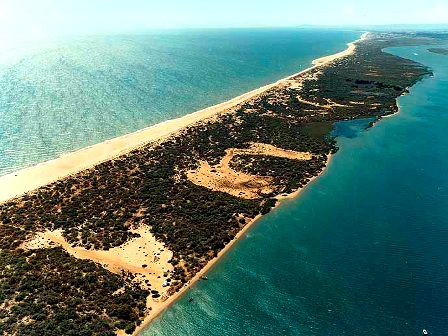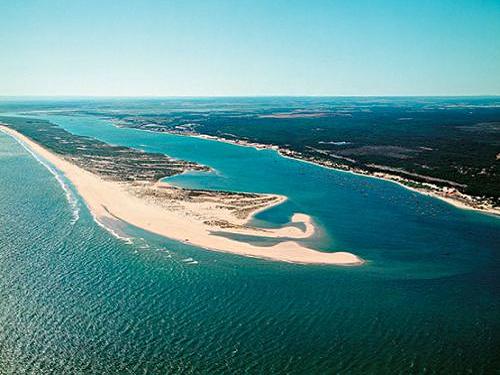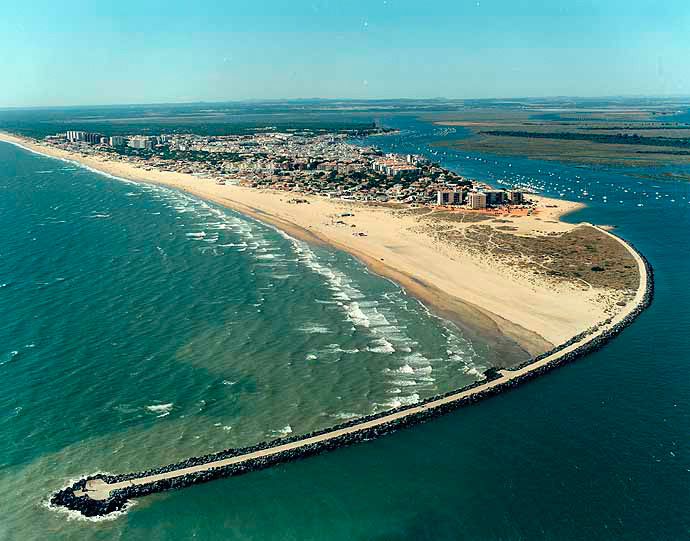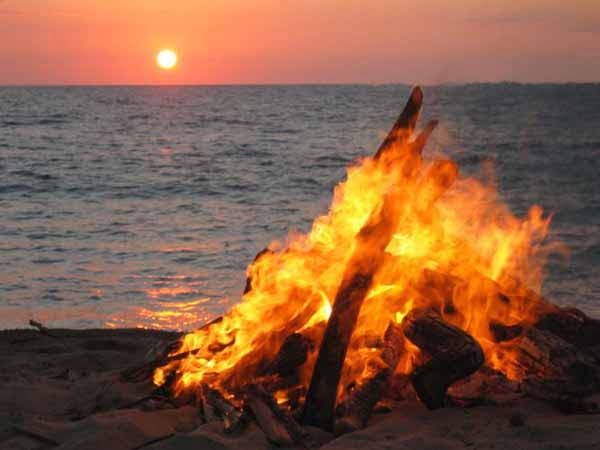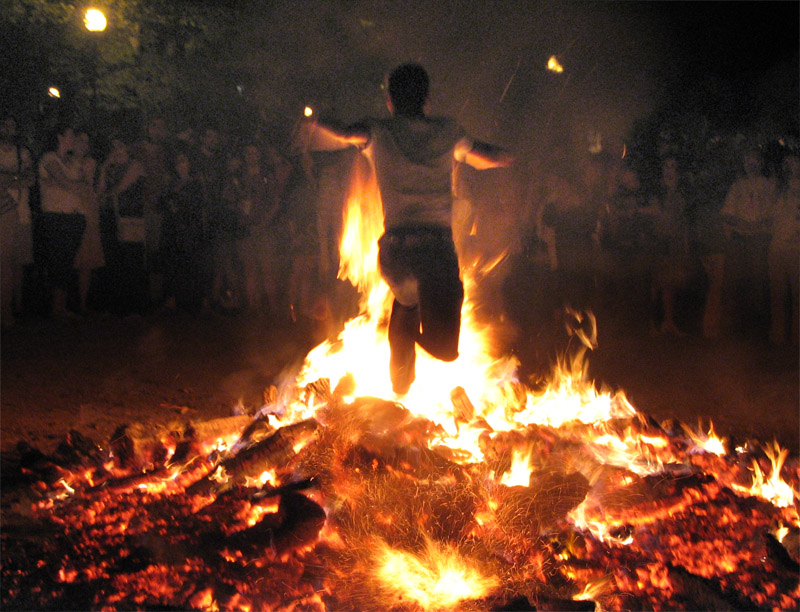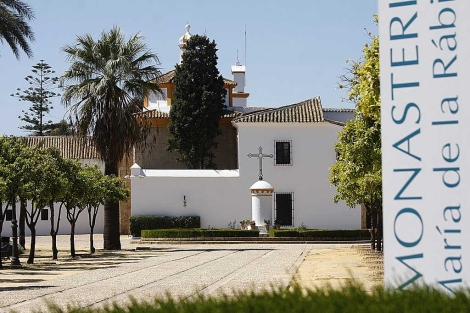Wharf of the Caravels. (discover it with www.spainsouthwest.com, touristic services and legal assistance)
The Wharf of the
Caravels (Spanish: Muelle de las Carabelas) is a museum in Palos de la
Frontera, in the province of Huelva, Andalucia, Spain. Its most prominent
exhibits are replicas of Christopher
Columbus's boats for his first voyage to the Americas, the Niña,
the Pinta,
and the Santa
María. These were built in 1992
for the Celebration of the Fifth
Centenary of theDiscovery
of America. The replica caravels were built
between 1990 and 1992, put through shakedown voyages and then, in
1992, sailed the route of Columbus's voyage.
The
museum is operated by the province of Huelva.
Throughout
1992 there were many celebrations of the fifth centenary of the Discovery of
America. Among these, in Spain, was the launching of replicas of the ships in
which Columbus and a crew that included the
Pinzón Brothers of
Palos de la Frontera, the
Niño Brothers of Moguer, and other mariners from the region
made the voyage that is generally accounted as the discovery of the Americas byEuropeans. These three boats formed part of
the Seville Expo '92 and were part of
numerous expositions throughout Europe and the Americas.
After
they had been used in all manner of activities—including being used in filming 1492: Conquest of Paradise—the Andalusian Autonomous Government acquired the
replicas as part of the project Andalucía 92. The key to this project was the
construction of the Wharf of the Caravels near La
Rábida Monastery in
Palos de la Frontera, one of the key Lugares
colombinos, sites associated with the preparation and launching of
Columbus's first voyage. The resulting museum, inaugurated in 1994, is managed
by the Diputación de Huelva, the government of Huelva province.
Since
the, the Wharf of the Caravels has been open to the public, with the number of
visitors increasing each year. In 2007, nearly 200,000 people visited, roughly
550 people a day. It
is the third most visited tourist site in Andalusia. August is the
busiest month in terms of visitors.
Interpretive
Center
The
Wharf of the Caravels is entered through a vestibule with a ticket window.
Beginning there, one can visit, through rotating modules, an exhibit about 15th
century society and numerous exhibits related to Columbus's voyage of
discovery: replicas of maps, arms, treaties such as the Tratado de Tordesillas and the Treaty
of Alcáçovas. The upper part of the building holds an exhibit of Pre-Columbian art.
One
of the featured exhibits is an Audio-visual production about
half an hour in length, shown in a hall with a capacity of 120 viewers. After a
brief piece on other important local tourist sites such as the La
Rábida Monastery and
the Forum of the Organization of Ibero-American States(Foro
Iberoamericano de La Rábida). The
narration is from the point of view of the sailors who made the voyage.
Replicas of the
ships
The
chief draw of the museum is the trio of replica ships: the Pinta, Niña,
and Santa
María. The replicas were fashioned in the fishing port
of Isla Cristina in western
Huelva province as part of the celebrations of the fifth centenary of the
Discovery of America, and were the principle motive to create the Wharf of the Caravels.
They are now located at a semicircular dock. Visitors can board and tour each
ship for a firsthand view of their holds and cabins. The Pinta and Niña are on the ends,
flanking the Santa
María. Although the historical reproductions were
rigorous in terms of the general lines of the ships, to facilitate visitor
access the Pinta has one small,
deliberate deviation from what was indicated in the sources: a staircase to the
ship's hold. The hold of the Niña cannot be
visited, because its design, more faithful to history, would not allow a means
to reach the hold that would be safe enough to open to the general public. The
larger Santa
María features
Columbus's cabin, with a man impersonating a scribe, as well as access to the bowels of the
ship.
Medieval
neighborhood
Near
the dock that is the Barrio
Medieval, a reproduction of a medieval port
neighborhood, reconstructing the environment in which common people lived
around the time of the voyage of discovery, by means of such elements of daily
life as a market, a pottery factory, and
numerous carts, and a recreated tavern where
museum goers can by food and drink. This
area is a loose recreation of the medieval port of Palos de la Frontera (some 4
kilometres (2.5 mi) away), in
line with the spirit that can be seen throughout the museum: to recognize the
contributions of this area to the discovery of America. The neighborhood has
the capacity for more visitors at a time than any other part of the museum.
Many
objects in the market—ceramics, ironwork, objects
made from esparto fiber—are
there to give the outlines of what would have been carried in the holds of
ships. Also on display is fruit-in fact, plastic replicas of
fruit-typical of the region at that time.
Isla del
Encuentro
The Isla del
Encuentro ("Island
of the Encounter") attempts to recreate the world the crew of Columbus's
first voyage encountered on their arrival at the island of Guanahani, where
they first made landfall in the Americas. An
effort has been made to represent the indigenous culture. On the one side is a cottage with wood
framing and reed walls; on the
other, the people living on the island are represented by statues, representing
people going about such ordinary activities as fishing or cooking; various
objects of daily life are also on display, as are replicas of fauna typical
of the Caribbean, including tortoises, parrots and various
species of fish.
The
museum as film set and event location
The
Wharf of the Caravels, and especially the three replica ships, has been used
for its ambience or details in several films related to Columbus's voyage. Vicente Aranda has used the
museum as a set in two if his films, Mad
Love and Tirant lo Blanc.
Also, various other events have been held at the museum, especially
commemorations related to the voyage of discovery. Because the museum is open
year-round, events can be held there on August 3 (the day of Columbus's
departure), March 15 (the day of Columbus's return) and October 12 (landfall in
the Americas), among
others. The museum is also used as a location for other events that have little
to do with the voyage of discovery.










